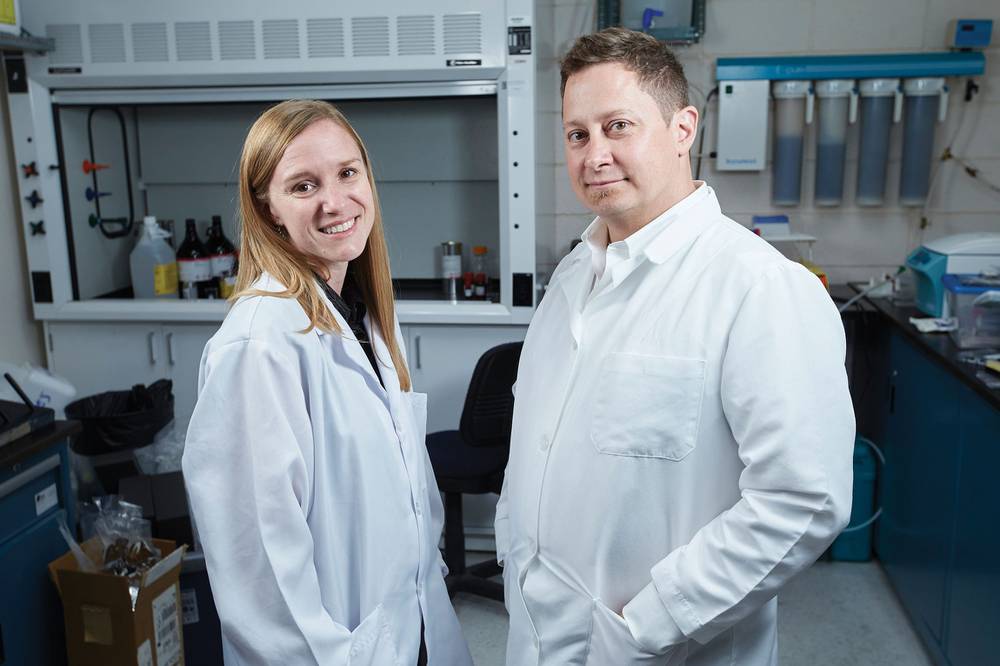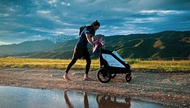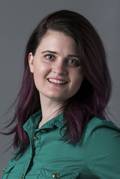For thousands of years, humans have used psychedelics for religious and therapeutic purposes. And yet, mainstream medicine has been skeptical of—if not downright hostile to—this class of drugs. Meanwhile, that very same mainstream medical community is falling short when it comes to treating mental health issues like depression, anxiety, PTSD and addiction.
But that’s slowly changing. Psychedelics are making a comeback from their heyday in the ’60s and ’70s. Around the world, serious researchers are cautiously exploring the science behind hallucinogenics as possible therapy for a range of mental disorders including obsessive-compulsive disorder, post-traumatic stress disorder, alcoholism, anxiety and depression. Psychedelics such as psilocybin (the active ingredient in mushrooms) have even been declared “Breakthrough Therapy” by the Food & Drug Administration.
UNLV neuroscientists Dustin and Rochelle Hines are two such researchers. The married duo are busy publishing research papers, seeking grants and teaching students. “We’re all about innovation,” Dustin says. “I believe that in the next five to 10 years, there will be significant change in this field.”
The couple alternates between enthusiasm about the substances’ therapeutic possibilities and fear of them being misunderstood.
“We’re sometimes caught in the social stigma between people who don’t think this can be a therapeutic—that it’s just some drug out of the ’60s and ’70s—and then other people who think everyone should take this drug,” Dustin says. “Really, what we’re trying to do is provide evidence-based research to say here’s who, where, when and how this will help. We have just scratched the surface of that.”
The fact that so little is scientifically understood about psychedelic compounds makes for a fertile area of research. Recently, the Hineses discovered a brainwave signature that allows researchers to better study the effects of psychedelics. They’re also studying how different compounds interact. For example, a recent research paper found a synergy between psychedelics and nicotine.
For millennia, Mesoamerican cultures have combined nicotine and psychedelics for medical and ceremonial use. “We don’t really even understand why they combined it with psychedelics,” Rochelle says. “We just wanted to try to understand that and try to understand what they already knew.”
She cautions that their research is in no way an endorsement for cigarette smoking. In fact, the scientists are cagey about describing the specific results of their research due to the fear of inspiring the public to take matters into their own hands. “We don’t want to educate the public to do something that we don’t think is a good idea,” Dustin says. “That everyone should just go and do drugs? That everyone should just go and mix psychedelics with compounds? It’s a terrible idea.”
For example, the Silicon Valley trend of microdosing LSD to improve on-the-job creativity—well, that turns out to be mostly a placebo effect. “These are the kinds of things we’re trying to avoid—where people think they can read a paper, go out, ingest a whole bunch of compounds and just make things work better for themselves,” Dustin says.
For better or worse, the general public will have to wait for science to catch up. “We do believe in the power of these compounds as a potent therapeutic,” Rochelle says. “But in order to really legitimize that, we want to make sure we have the appropriate evidence, and that we know the parameters so that they can be used safely and efficaciously.”
The ultimate goal is to develop a product that is both clinically useful and safe, according to Rochelle. “We have a lot of anecdotal evidence behind these compounds,” Rochelle says. “Now it’s time to put them to the test in the lab and really develop the evidence.”
The duo has a number of projects in the works, and they are studying therapeutic treatment for a variety of different disorders.
“We study very different things,” Dustin says. “Everyone thinks we’re both neuroscientists, which we are, but there’s a lot of difference between how Rochelle approaches things [and how I do].” Rochelle focuses more on the micro or cellular aspects of the brain, while Dustin prefers to zoom out to look at “the behavioral and the circuit level.”
Rochelle’s interest is in neurodevelopmental disorders, i.e., how babies’ brain cells develop. Meanwhile, Dustin is studying certain brain cells called glial cells that might be able to help with early disease detection.
Ultimately, the couple aspires to create a unifying theory of the brain. So many scientists are studying tiny aspects of the brain, Dustin says, but the duo is seeking the bigger picture. “We want to look at the brain at this mezzo and macro level, and put it all together,” Dustin says. “The time is right for one of these unifying theories of neuroscience to look at not a single cell, but all the cells, all the receptors, all the circuits.”
“To make a crude analogy: For a long time in neuroscience, we’ve been studying violins. We know a lot about what a violin sounds like, and maybe even a cello,” Rochelle says. “But now we need to put those things together and understand how all of the instruments would play together to make music.”
“A symphony, if you will,” Dustin says. “That’s a great analogy. That’s why she’s the smart one.”
Tips for optimal brain health
It’s fun to read about the latest in psychedelic research. But since it will be a while till the results of the studies trickle down to the rest of us, neuroscientists Rochelle and Dustin Hines offer these tips for keeping your brain in tip-top shape:
“The simplest answer is use it or lose it, so you just have to keep active,” Dustin says. “I don’t think there’s one single activity to do. But using your brain every day is really important.”
In terms of how to best exercise your brain daily, Dustin recommends opting for low-stress hobbies.
In raising their two sons, Rochelle says that they’ve applied principles from neuroscience. For example, they expose their kids to a wide variety of experiences. They read to their children every day. They talk to their kids without talking down to them, using their full adult vocabulary and then explaining things that might be unclear.
Ultimately, one of the healthiest things to do is to connect with others. “We engage with our students, we engage with members of the community, we communicate with others,” Rochelle says. “Because it’s rich for us, and hopefully, rich for others as well.”
UNLV expands its offerings
New opportunities abound for university students who want to learn more about the brain. UNLV now offers an undergraduate minor in neuroscience as part of the Psychology Department. The Hineses are also excited about UNLV’s new interdisciplinary Ph.D. program in neuroscience. “It brings together clinical researchers from different colleges and then us from the College of Liberal Arts and the School of Medicine,” Rochelle says.


